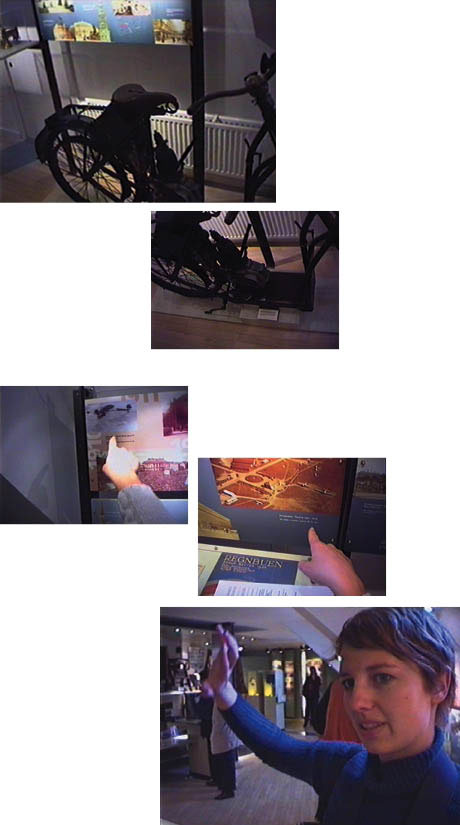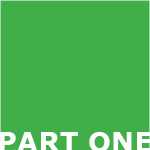Chapter 9:
Person-in-situation (1)
– Experience and strategy
This is one of a series of projects that looks at the person-in-situation. These kinds of projects are framed with a phenomenological approach and the methodology used was presented briefly in chapter 8. The book, Researching Experiences: Exploring Processual and Experimental Methods in Cultural Analysis, provides a detailed presentation of the overall methodology and theory (Gjedde & Ingemann 2008).
This chapter focuses on the outcome from following two visitors into the universe of a historical museum in Copenhagen, where there was an exhibition dealing with democracy. The starting point of my epistemological interest is not the intentions of the museum or the curator with respect to how they imagine visitors who use the exhibition in the museum to be. Instead, the aim of my analysis is to investigate and argue for the plurality of meaning in the authentic artefacts and the elements that support the story of the objects and the overall narrative.
During the project relations emerged early in the process as the main keyword, e.g. the relation between objects and reality; object and object; object and text; and the most important relation: between object and visitor. In this search for the potential meaning, the exhibition has the necessary opportunities and diversity, which are the most important aspects of an exhibition from the visitor’s point of view. There is of course a huge difference between the potential meaning and the meaning that is realised. The well-known reception theorist Stanley Fish claims categorically, “The text does not exist” (1980).
The text can momentarily be seen as the conglomeration of elements I mentioned earlier. Fish believes that there is no text until the reader or the visitor actualises the physical conglomeration of elements. The visitor creates the text and only the part of the text that is actualised becomes the text for the reader. According to Fish the individual reader creates the text. Anthropologist Edwina Taborsky shares this view, but she differs on one important point, namely that the text is created by a social practice, because it is through direct speech between visitors on the physical conglomeration of elements that the text is actualised and then becomes visible and conscious (1990).
‘Under the wings of democracy’ and Anne
Anne (25) walks around in the exhibition with her friend Rikke (25) for an hour. The immediate impression their walk-video gives is that the two women talk a great deal and seem to be very engaged and interested visitors. They find objects, photographs and information to show each other that are related to their own lifeworlds. Afterwards, the outline I make of their walk shows that they spend twice the amount of time looking at the timeline on the walls as they spend looking at the islands with many objects. They spend one and a half as much time on the island with 1960-1970s objects as they do on the objects from 1920-1930 (Gjedde & Ingemann 2008).
The time they spend on the individual parts of the exhibition shows that they look at more photographs and pictures, namely 55, than they do at objects, namely 30. The authentic photographs could be defined as things and objects taken from one context and put into another in the museum due to the musealisation process. Instead of employing the photographs in this way, Anne uses them more as communication, and in this context with the texts, the use of the pictures transforms them from objects into narratives in pictures and text as a kind of history book on the walls. The hidden history of the pictures is more easily revealed, helped by the text. There is also a text close to the objects but it seems immediately more difficult to unpack. What are the objects going to tell?
First I will show how the fragmented visual and verbal utterances can be categorised and afterwards how they can be used to indicate something about the reading strategies Anna uses to create meaning in chaos.

 Ill. 3.2: Screen dumps from Anne’s walk-video: famous inventor Jacob Ellehammer’s motorcycle, a placard with his aeroplane and a peek at the exhibition room. Ill. 3.2: Screen dumps from Anne’s walk-video: famous inventor Jacob Ellehammer’s motorcycle, a placard with his aeroplane and a peek at the exhibition room.
Anne – and the four reading strategies
Anne’s walk through the exhibition oscillates between the four reading strategies. She uses The locked gaze and recognises something new to her, i.e. that the first Christmas tree in Denmark was set up in Town Hall Square in 1912. She also recognises other items: the album covers from Tommy Steel, the Beatles and Savage Rose, as well as the first time the famous Little Mermaid statue had its head cut off. There is also an enormous number of artefacts that do not attract her attention in any other way than her recognising them, the level of interest too low to initiate a barrage of psychological reactions. The way she looks at them indicates that they verge on being boring, but on the other hand she does not really see them.
She uses The opening gaze and gets surprised. She looks at something familiar and ugly: a shopping cart loaded with unappetising food. She looks at something she finds aesthetically beautiful: an excellent photograph of boats in a canal in the winter or one of lights reflected in a lake. She looks at architecture: ugly high-rise buildings that grow uglier and uglier and contrasts them to the B&W building, which remains as beautiful as the day it was built. She is surprised how she remembers through her senses, e.g. feeling the weight in her hand of a heavy telephone receiver her grandma and grandpa still have. She also connects an old picture of the Copenhagen Airport with her new, personal experiences of seeing the renovated one. She lets her self be surprised and provoked by the emotions and experiences the artefacts recall and how the experiences come to mean something to her.
She uses The pragmatic gaze and finds that which touches upon her daily life. She connects the photograph of Nyhavn with her aunt’s view of Nyhavn as a street where hookers hang out. She sees Carmen Curlers and remembers clearly how she got her hair so tangled up as a child that it had to be cut off. Anne constantly tries to find connections between the artefacts and herself. When she comes to 1973 on the timeline, she clearly exclaims, “… this is when I was born!” She finds her way back to earlier models of her life which hit her like a nostalgic flashback. She uses The reflecting gaze and mirrors her own life in others’ lives. She becomes tremendously engaged in the “How-do-I-feel-today” barometer and the life and culture it stems from. She clearly marks a distance to that life in relation to her own values and standards.
Anne switches between reading strategies when she moves through the exhibition, choosing in relation to some artefacts The opening gaze, while employing The pragmatic gaze in relation to others. But this is only partly true, because she also switches between different reading strategies in front of a single artefact. The episode with the Carmen Curlers is a good example. Surprised by seeing something familiar in the exhibition, she chooses The opening gaze, but she does not remain in the recognition stage by saying to herself: here are curlers and they became modern in the 1970s. Looking at them more deeply she moves to The pragmatic gaze, linking the curlers to strong personal experiences from her childhood. But she also uses The reflecting gaze and takes exception to using those kinds of curlers today. They are part of the past, part of a different culture, another generation and another life than the one she lives today. Lucky her, she feels. This example shows that her reading strategies are certainly dynamic and fluctuating.
Anne’s exhibition and the narrative
What kind of narrative does Anne create in the exhibition? She creates or does not recreate the narrative of the exhibition about the municipality, the labour market, the home and consumption. She naturally has understood the fundamental structure of the exhibition because she is a thorough reader. To a great extent she uses The locked gaze and tries to understand what she is intended to understand. But she also meets the exhibition with her previous knowledge and values. She creates the text in collaboration with her friend, Rikke, and what she sees is quite another exhibition than the intended one.
The analysis of the six relational categories and the four gazes draws a picture of a visitor exceedingly concerned about two issues: aesthetics and quality in her relation to the artefacts. For Anne, relating personally to the artefacts is vital. She is occupied with time and with relating the artefacts to time, which is why the timeline on the wall is critical for her. She gets surprising knowledge about pictures and objects from the timeline, which obviously engages her more than in the original objects. The objects are not unimportant because they fit into her fundamental expectations that a museum must have objects. They represent an available opportunity and are not something she actually uses in her construction of her visit to the exhibition.
Anne is open and willing to be surprised. Even if the artefacts are not remarkable she is good at finding surprising ways to connect herself to them. Willing to find another reading strategy if the previous one is unsuitable, Anne easily moves between each of the four reading strategies, but this does not mean that everything is possible. She excludes large quantities of experiences and knowledge because in addition to being open she is simultaneously closed. When choosing The opening gaze and The pragmatic gaze she searches for something that can surprise her, that she can relate to personally and that reflects her values that focus on the aesthetic, the quality and the story. The framework provided by the timeline on the wall contributes greatly to her experience because it becomes a part of the way she structures her own narrative. The aforementioned values however cause her to exclude a rich array of possible stories that could be constructed based on the exhibition. For her the aesthetic quality is closely connected to craftsmanship and her senses. She uses her senses to relate to many of the artefacts she has a personal relationship to, for example Carmen Curlers, telephone receivers, toys etc.
An extremely well-functioning informant, Anne to a great extent is able to verbally articulate what she experiences during her walk around the exhibition. She and Rikke are also involved in a close dialogue in which Rikke alternates between being accepting and challenging what Anne says.
An interesting issue is the relationship between the real-time experience and the period of reflection. There is the moment where attention is paid to an object that provides the feeling of creating an experience and then there must be a time gap to allow for reflecting upon what happened. From my experience this moment can be as brief as a few seconds. The crucial aspect is not time but the situation in which dialogue is constructed around the experience. When the two friends walk through the exhibition they are mainly present in the experience and not the reflection stage, which puts them in the position of talking-in rather than talking-about the experience (see also Leinhardt & Knutson 2004).
|


